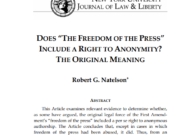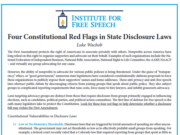In a recent interview with Watchdog.org, Federal Election Commission Vice Chair Ann Ravel compared campaign finance disclosure with the nutritional information on a box of cereal, stating that such “information is important for people to know whether they want to buy it or not . . . similarly people should know who’s making large contributions to campaigns so they can get a sense of how to vote.” But is voting really like purchasing cereal? A recent election-related controversy in Montana suggests some flaws in this analogy.
Commissioner Ravel’s justification for disclosure falls under the rubric of “heuristics” – the idea that contextual cues can be used as shortcuts for decisionmaking – and, indeed, this rationale for campaign disclosure has support from some powerful authorities. In perhaps what is one of the less considered parts of the Supreme Court’s landmark opinion in Buckley v. Valeo, a major cornerstone for modern campaign finance law, the Court stated that disclosure of information about candidates’ financial contributors “provides the electorate with information ‘as to where political campaign money comes from and how it is spent by the candidate’ in order to aid the voters in evaluating those who seek federal office. It allows voters to place each candidate in the political spectrum more precisely than is often possible solely on the basis of party labels and campaign speeches.” (emphasis added). In short, according to this view, a candidate’s contributors give voters information about where the candidate stands.
Yet, just the other week, we saw how kindly political speech regulators took to this heuristic approach to disclosure in practice, when researchers at Stanford University and Dartmouth College did exactly as Ms. Ravel and Buckley suggested. In an attempt to see whether voter turnout would increase in response to providing voters with more information about candidates, the researchers sent mailers to voters in Montana graphically depicting where the Montana Supreme Court candidates fall on the ideological spectrum relative to President Obama and Mitt Romney. As the researchers explained on their website, the information was derived from correlations between the candidates’ respective campaign donors and donors to Messrs. Obama and Romney. In other words, they used campaign finance data “to place each candidate in the political spectrum” (to borrow the language of Buckley) in an effort to give voters “a sense of how to vote” (to borrow Ms. Ravel’s language).
The response from certain quarters was overwhelmingly negative. Senator Jon Tester (D-MT) denounced it as “voter manipulation.” The Montana Secretary of State filed a complaint with the Commissioner of Political Practices, who, in turn, bandied about the prospect of an $80,000 fine and demanded an apology from Stanford and Dartmouth. Although the mailer’s use of the official Montana state seal was cited as part of the reason for the condemnation, that seems like more of a pretext and cover for the actual underlying and unstated objection, since the mailers clearly disclosed their sponsors and did not otherwise purport to be official government communications. Could it be that providing the voting public with this type of heuristic information isn’t so attractive in practice as it seems to be in theory?
Putting aside the flap in Montana, consider the wisdom of the heuristic rationale for campaign disclosure in the abstract, and whether the Buckley Court reached the right conclusion about this issue in the first instance. Under the analytical framework the Court has constructed, campaign disclosure laws are subject to “exacting scrutiny,” meaning they must further “governmental interests sufficiently important” to outweigh the burdens of disclosure. Yet, what governmental interest exists at all, let alone one that is “sufficiently important,” to encourage the electorate to take shortcuts in deciding how to cast their vote, rather than to put even a modicum of effort into evaluating the candidates and their positions on their own merits? By accepting the heuristic rationale under the exacting scrutiny standard, the Buckley Court essentially endorsed copycat voting.
Moreover, if heuristics is such a compelling rationale for disclosure, then why shouldn’t we also scrap non-partisan elections, which fail to disclose candidates’ party affiliation on the ballot? After all, such information also “allows voters to place each candidate in the political spectrum” (albeit not as precisely as campaign contributor information, per the Buckley Court, which apparently was an expert on the mathematical precision of heuristic cues in voting behavior). Which brings me back to the Montana mailers. According to the Associated Press, a major part of the objections to the materials was that they “injected partisan politics in a nonpartisan race.”
If heuristics is not a legitimate rationale for campaign disclosure requirements, as my examples above suggest, then disclosure advocates ought to stop relying on this justification. Otherwise, they may end up unintentionally proving the corollary to the axiom that “sunlight is said to be the best of disinfectants” – which is that too much of it can also cause sun damage.














